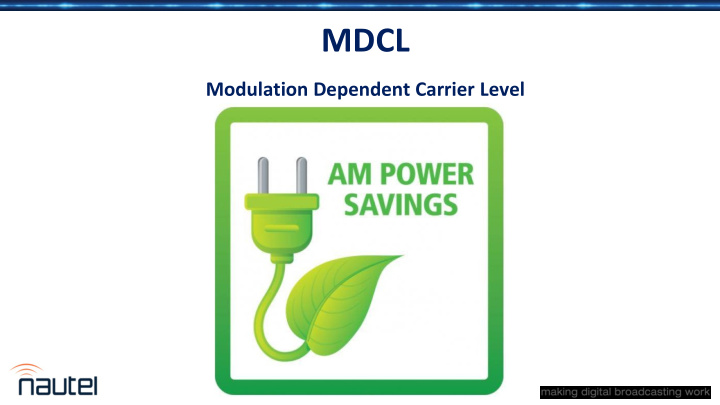



MDCL Modulation Dependent Carrier Level
Agenda Overview ✓ Theory What is it? ⁻ Jeff Welton, CBRE Regional Sales Manager Central U.S. ✓ Benefits Why do it? ⁻ ✓ Implementation How do we get it? ⁻ Cris Alexander, CPBE Director of Engineering Crawford Broadcasting Corporation
Your questions please? (if you don’t see the control panel, click on the orange arrow icon to expand it) Please enter your questions in the text box of the webinar control panel (remember to press send) Remember: The completion of a Nautel webinar qualifies for ½ SBE re-certification credit, identified under Category I of the Re-certification Schedule for SBE Certifications.
Timeline Forms of MDCL (also known as DCC – Dynamic Carrier Control) have been used for decades in ham radio. DCC or variations have been used in European AM broadcast since the 1980s and have been available for Nautel transmitters since 1995. At NAB2009, Nautel presented a white paper on MDCL. In late 2010, Alaska Public Radio was granted experimental authorization to begin testing MDCL on several of its stations. In September 2011, the FCC issued a Public Notice (DA 11-1535) approving the use of MDCL and leaving the specific algorithm up to the individual broadcasters. Since then, several US broadcasters have implemented MDCL and have reported power savings of 20-40%
Glossary MDCL: Modulation Dependent Carrier Level - general name for the set of technologies, where carrier amplitude is varied relative to modulation AMC: Amplitude Modulation Companding - reduces both carrier and audio amplitude at high mod depths. Maintains S/N ratio DAM: Dynamic Amplitude Modulation - reduces carrier only at low mod depths. Higher savings but at the cost of increased S/N (fringe coverage affected) DCC: Dynamic Carrier Control - a version of DAM (although the term DCC is also occasionally used to refer to the overall technology.
Theory The AM carrier does not contain any information, yet contains more than 2/3 of the total transmitted power. Effectively, MDCL involves analyzing mod depth and dynamically adjusting carrier level (and audio level to maintain mod depth) to reduce peak power level.
Modes of Operation
Modes of Operation
Modes of Operation
Modes of Operation
Modes of Operation
Customer Feedback “For both November and December of 2011, our energy usage was reduced by 21% over the same period in 2010.” “I have had the opportunity to evaluate the effects of the MDCL operation on the signal firsthand and … well… I haven’t detected any. The signal is strong and robust, maybe even louder than before “
Other benefits • Reduced peak power • Less stress on components, especially with aging infrastructure
Observations from Cris • Used AMC to keep AGC active in receivers – full power at low mod keeps AGC from increasing gain and attendant noise. • Listening tests showed no perceived impact on signal strength or quality, even in fringe areas, using AMC3 • 50kW stations typically saving 1000-1500.00/mo … converting tower lights to LED increased even further • If you are in an area with demand billing, running an aux transmitter can wipe out the month’s savings… keep an eye on that! • MDCL requires a lot less generator. KBRT is 50kW with AMC3 MDCL and the entire site runs on a 70kW generator, transmitter, lights, A/C and 120V loads!
Specifics -A waiver of 73.1560(a) is required. This can be requested by letter to the FCC -Some effect on audio quality and/or coverage may be seen with different algorithms -There are several algorithms available (5 from Nautel), user selectable, for least impact on coverage/audio
Compatibility On Nautel NX series transmitters, it’s as simple as turning it on
Compatibility On ND, XL and XR series transmitters running AM-IBOC, it requires a firmware or platform upgrade.
Compatibility For XR series transmitters NOT running AM-IBOC, an external DCC unit is required.
Compatibility For older ND and XL series transmitters not equipped with AM- IBOC, some upgrades are required. - RF and Mod (PDM) drivers need to be replaced - an interface board needs to be installed to interface to a DCC unit - a DCC unit will need to be installed
0.5 1.5 2.5 0 1 2 3 9:33:35 mod 100% MDCL No 9:35:11 Measured Power Consumption in various modes 9:36:47 9:38:23 9:39:59 9:41:35 9:43:11 9:44:47 9:46:23 9:47:59 mod 150% 3dB AMC 9:49:35 9:51:11 9:52:47 9:54:23 9:55:59 9:57:35 9:59:11 10:00:47 10:02:23 10:03:59 mod 150% 4dB AMC 10:05:35 10:07:11 10:08:47 10:10:23 10:11:59 10:13:35 10:15:11 10:16:47 10:18:23 10:19:59 mod 150% 5dB AMC 10:21:35 10:23:11 10:24:47 10:26:23 10:27:59 10:29:35 10:31:11 10:32:47 10:34:23 mod 150% 6dB AMC 10:35:59 10:37:35 10:39:11 10:40:47 10:42:23 10:43:59 10:45:35 10:47:11 mod 150% boost 1.76dB 3dB EAMC 10:48:47 10:50:23 10:51:59 10:53:35 10:55:11 10:56:47 10:58:23 10:59:59 11:01:35 11:03:11 mod 150% boost 1.76dB 4dB EAMC 11:04:47 11:06:23 11:07:59 11:09:35 11:11:11 11:12:47 11:14:23 11:15:59 11:17:35 mod 150% boost 1.76dB 5dB EAMC 11:19:11 11:20:47 11:22:23 11:23:59 11:25:35 11:27:11 11:28:47 11:30:23 11:31:59 mod 150% boost 1.76dB 6dB EAMC 11:33:35 11:35:11 11:36:47 11:38:23 11:39:59 11:41:35 11:43:11 11:44:47
nautel.com/am-mdcl-savings/
Questions?
Online Information • Nautel Waves Newsletter http://www.nautel.com/newsletter/ • Webinars http://www.nautel.com/webinars/ • YouTube http://www.youtube.com/user/NautelLtd
Recommend
More recommend